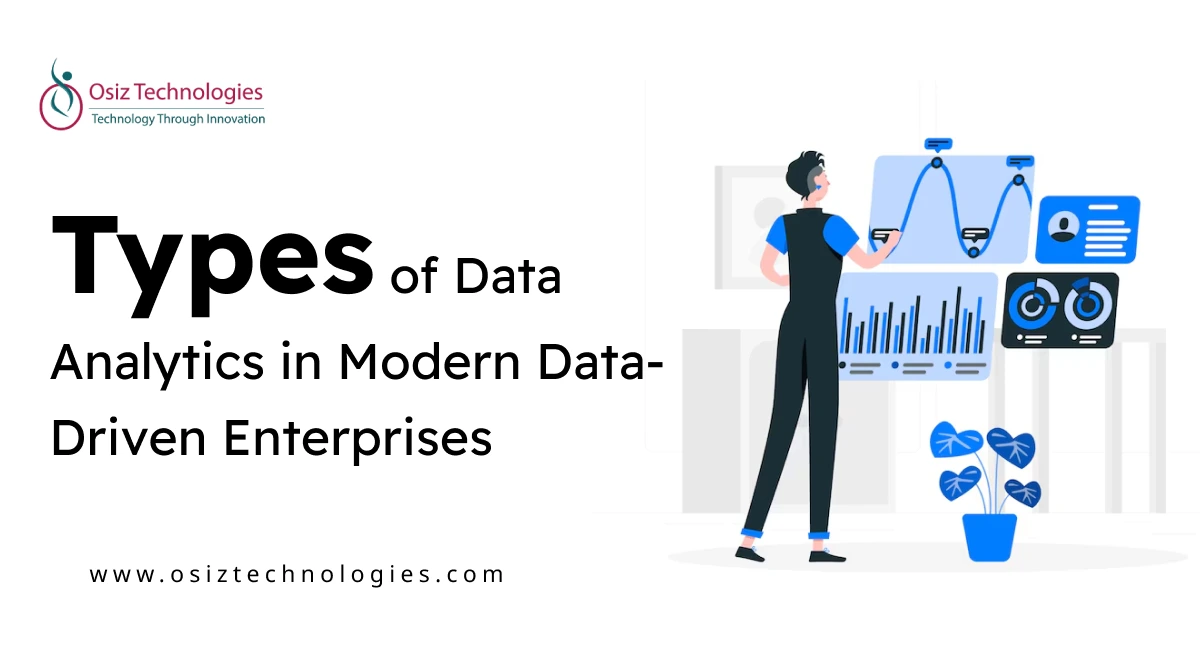Introduction to Data Analytics in Enterprises
Data analytics is the structured process of collecting, examining, and interpreting data to extract meaningful patterns and insights. For enterprises, this means turning operational, customer, and market data into actionable intelligence. From optimizing workflows to predicting customer preferences, data analytics has become a critical asset for business growth and competitive advantage.
Modern enterprises rely on different analytics techniques not only to understand what has happened but also to uncover why it happened, predict future outcomes, and recommend the best possible actions.
Why Data Analytics Matters for Modern Businesses
Data analytics has become an essential tool for modern enterprises, enabling them to turn vast amounts of raw data into valuable, actionable insights. This empowers businesses to stay agile, customer-focused, and operationally efficient.
With data analytics, businesses can:
-
Understand customer behavior and preferences to deliver personalized experiences
-
Identify operational inefficiencies and uncover areas for improvement
-
Predict future market trends and customer demands, enabling proactive decision-making
-
Reduce business risks by detecting potential issues before they escalate
-
Optimize marketing, finance, and supply chain operations with real-time insights
The ability to gather, process, and analyze data effectively allows enterprises to make evidence-based decisions that drive growth, improve profitability, and enhance customer satisfaction. In short, data analytics is no longer a luxury for modern businesses — it’s a necessity for survival and sustained success.
4 Key Types of Data Analytics
For enterprises aiming to become truly data-driven, understanding the fundamental types of data analytics is essential. Each type plays a distinct role in capturing insights from business data and transforming them into value-generating decisions. Let’s explore the four core types of data analytics and why each is a critical component of a modern business intelligence strategy.
Descriptive Analytics: Interpreting the Past
Descriptive analytics forms the groundwork for every data strategy. It focuses on summarizing and interpreting historical data to provide clear, factual insights into past business performance. By consolidating large volumes of raw data into digestible insights, descriptive analytics highlights trends, patterns, and operational outcomes over time. It allows enterprises to track key metrics, monitor business health, and establish benchmarks that inform decision-making processes.
Why It Matters:
In a data-driven organization, having a clear understanding of what has happened in the past is crucial for identifying areas of success and concern. Descriptive analytics provides the essential context needed to evaluate business performance objectively, making it easier to justify changes, set realistic goals, and communicate results to stakeholders.
Diagnostic Analytics: Understanding the Cause
While descriptive analytics reveals what occurred, diagnostic analytics dives deeper to explain why those outcomes happened. It analyzes relationships between data variables, identifying root causes, trends, and correlations that influenced specific business results. This type of analytics helps enterprises uncover the factors behind operational issues, customer behaviors, or market changes, offering a comprehensive understanding of performance drivers.
Why It Matters:
Without knowing the reasons behind a particular outcome, decision-making remains reactive and incomplete. Diagnostic analytics equips enterprises with insights into the ‘why’ behind their data, enabling them to address inefficiencies, correct course, and make smarter, evidence-based adjustments.
Predictive Analytics: Anticipating What’s Next
Predictive analytics enables businesses to move from understanding past and present data to forecasting what could happen in the future. It applies advanced statistical techniques, AI, and machine learning to detect trends and patterns that suggest likely future scenarios. This type of analytics is essential for anticipating customer behaviors, market shifts, operational risks, and business opportunities.
Why It Matters:
In today’s competitive, fast-paced business environment, the ability to anticipate future outcomes offers a significant advantage. Predictive analytics allows enterprises to plan proactively, allocate resources efficiently, and position themselves ahead of emerging trends.
Prescriptive Analytics: Guiding Actionable Decisions
Prescriptive analytics is the most advanced form of data analytics, providing actionable recommendations based on historical insights and predictive forecasts. It uses optimization algorithms, simulation models, and decision analysis to suggest the best actions for achieving desired outcomes. This type of analytics empowers businesses to evaluate different scenarios and make informed choices with a high degree of confidence.
Why It Matters:
Prescriptive analytics closes the gap between insight and action. While other analytics types inform and predict, prescriptive analytics advises on what steps should be taken next. This capability is vital for businesses that need to optimize operations, reduce costs, improve customer experiences, and stay agile in response to market changes.
Benefits of Using Multiple Analytics Types
In a modern data-driven enterprise, no single analytics type can address every business challenge. Here’s why combining them matters:
Offers a Comprehensive Data Perspective: When analytics types work together, businesses can move from knowing what happened to understanding why it happened, predicting what’s likely next, and deciding how to respond. This end-to-end data journey ensures clarity across operations, market trends, and customer behaviors — driving informed, connected business strategies.
Improves Decision Accuracy and Speed: Integrated analytics reduces guesswork. By validating predictions with historical patterns and identifying root causes, enterprises make quicker, evidence-based decisions. This improves accuracy while minimizing risks, ensuring that strategies are driven by reliable, multi-dimensional insights.
Enables Proactive Business Management: A combined analytics framework helps identify potential risks, market shifts, and customer trends before they impact the business. This proactive approach allows organizations to act early, adapt strategies, and seize new opportunities ahead of competitors.
Optimizes Resources and Operational Efficiency: Together, these analytics types highlight inefficiencies and recommend optimized actions. Businesses can allocate resources effectively, reduce waste, and improve process performance, leading to better cost control and streamlined operations.
Enhances Customer Experience Strategies: Integrated analytics helps decode customer preferences, predict future behavior, and recommend tailored actions. This drives personalized, timely, and value-driven interactions that improve customer satisfaction, loyalty, and lifetime value.
Final Thoughts
In modern data-driven enterprises, analytics isn’t just an option — it’s essential for sustainable growth. By leveraging comprehensive data analytics services, businesses can transform raw data into actionable insights, predict market trends, and inform informed decision-making at every level. As the volume and value of data continue to rise, enterprises equipped with strong, integrated analytics strategies will lead in innovation, customer experience, and long-term market leadership.
Listen To The Article
Recent Blogs

X-Mas 30%
Offer











